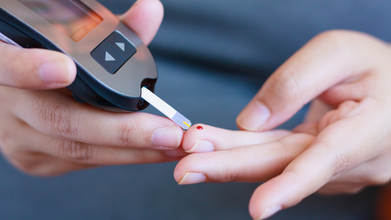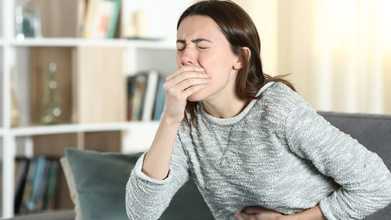- Health Conditions A-Z
- Health & Wellness
- Nutrition
- Fitness
- Health News
- Ayurveda
- Videos
- Medicine A-Z
- Parenting
What Your Snot Color Says About Your Health?

Credits: Canva
Seasonal changes are common, so is changes in the color of your snot, or nasal discharge. The color can tell a lot about your health. If you are confused about what it means, here's a quick guide that can help you see if you should go see a doctor.
How does it work?
The mucus in your nose protects your nose and sinuses from dust, bacteria and other environmental dangers. If you are in a heavily polluted environment, your snot may look green. If you have hay fever, it may be clear. In fact, a common cold may also cause your snot to look yellow or green. If your snot is red, brown or black, it may mean you have a nose injury, or are smoking.
What are the different color of snots?
The color varies between clear, white, shades of green and yellow, red and pink, shades of brown and orange and lastly black.
What is considered normal?
A clear snot is considered "normal" or healthy. Rhinitis or swelling of the mucosal membrane in the nose is a common cause of increased snot production , which could be clear.
There are various types of rhinitis, for instance allergic rhinitis or hay fever could also cause a clear snot. But how to know if it is a sign of hay fever if the color does not differ? You will notice that you have a runny nasal discharge and may feel a bit ill. However, there is nothing to worry as allergies are not caused by a virus. They are rather symptoms in your body's response to irritants like pollen, or animal fur, or dust mites.
Some can experience rhinitis without allergen exposure, which is what is known as the nonallergic rhinitis.
What does white snot mean?
If your nose feels stuffy, congested, then you may notice white snot. This can cause snot to lose its watery content, making it look white from a clear snot. This can sometimes be thick and cloudy too and may sign towards having a cold or an infection.
The common cold is also a frequent cause of white-colored snot. Your symptoms will usually develop a few days, usually two to three days after the exposure to virus.
What does yellow snot mean?
It indicates that your body is fighting an infection. The color yellow comes from the white blood cells which rush to kill the germs. Once the cells have done their, these cells are discarded in snot, which gives it a yellow shade.
What does green snot mean?
It means that your immune system has kicked in high gear to fight infection. The same white blood cells that fight the infection also includes other waste products, which gives it a green color.
Should you see a doctor? Sometimes it may not be a risky thing, and could just be a common virus and other foreign bodies present in the nasal passage.
What to do if you have red or pink snot?
It means that there is a sign of blood in your snot. This could happen because you have blown your nose too hard, or picked it too hard, scratching the surface, or had a hit to the nose.
What can be done?
- Apply Vaseline or another ointment to the nasal passages
- Using saline nose spray or gel to add moisture to your nasal tissues
- Trimming fingernails to prevent scratching your nose
- Adding moisture to the air with a humidifier
- Blowing nose gently
Brown or black snot and what it means?
Brown may indicate that the blood is exiting the body or is the old blood. It could also mean that you have accidentally inhaled something hot like paprika, or dust. However, if it persists, it is best to go see a doctor.
However, if you have black snot, you should definitely go see a doctor. This means that you are either a smoker, or using drugs. It could also be a fungal infection.
There are four types of fungal infection that can cause black snot:
Mycetoma fungal sinusitis: this happens from clumps of spores invading the sinus cavities
Allergic fungal sinusitis: this happens to people with a history of allergic rhinitis
Chronic indolent sinusitis: mostly found outside the US
Fulminant sinusitis: this could cause damage to the sinuses and the bony area that contains eyeballs and brain
When to see a doctor?
- If you have yellow snot with a fever that lasts for than 3 days
- a discolored snot with headache and burning eyes
- a discolored snot and swelling around the eyes
- black snot
Sudden Cardiac Death Risk Far Higher in People With Diabetes, Reveals New Study

Credits: iStock
A new study in the European Heart Journal has shed light on a worrying trend. People living with Type 1 and Type 2 diabetes face a much higher risk of sudden cardiac death, and this risk contributes to a significant loss of life expectancy. The findings also suggest that the true burden of sudden cardiac death in the diabetes population has been underestimated until now.
A Higher and Earlier Risk Than the General Population
Sudden cardiac death refers to an unexpected loss of heart function, often triggered by a sudden electrical disturbance in the heart. While many people assume this happens mainly to those with known heart problems, earlier research has shown that a large number of cases occur in individuals without diagnosed cardiac disease. This means vulnerable groups like people with diabetes may slip through the cracks of current prevention strategies.
Also Read: Is There A Link Between Your Kidney Health And Other Chronic Diseases? Lancet Study Says Yes
People with diabetes already face a shorter lifespan compared to the general population. On average, a 30-year-old with Type 1 diabetes loses about 14.2 years of life, while someone with Type 2 diabetes loses around 7.9 years. A major share of this reduction is linked to cardiovascular disease, and the latest study estimates that sudden cardiac death alone accounts for 3.4 years lost in Type 1 diabetes and 2.7 years in Type 2 diabetes.
What the Danish Study Revealed
To better understand the scale of the problem, researchers examined a nationwide cohort that included every person living in Denmark throughout 2010. For those who died during that year, detailed information was collected from medical records, autopsy findings when available, and death certificates. Two physicians independently reviewed every potential sudden death to ensure accuracy.
The dataset included more than 5.5 million people. During the year, 54,028 deaths occurred, and more than 14 percent were sudden deaths. People with diabetes made up a significant portion of these cases. There were 25,020 individuals with Type 1 diabetes and 172,669 with Type 2 diabetes, with 97 and 1,149 sudden cardiac deaths recorded in each group.
People with diabetes who experienced sudden cardiac death tended to be younger and more often male compared with people without diabetes. They also carried a heavier burden of other medical conditions, including ischemic heart disease, heart failure, arrhythmias, kidney disease, and even mental health issues. A notable proportion of these patients had also been hospitalized for diabetes-related complications such as hypoglycemia, which researchers believe could play a role in triggering sudden cardiac events.
Numbers That Highlight the Gap
The incidence of sudden cardiac death in the general population was 105 per 100,000 person years. In contrast, it climbed to 394 for people with Type 1 diabetes and 681 for those with Type 2 diabetes. The relative risk was especially striking among younger adults. For example, people between 30 and 40 with Type 1 diabetes had more than twenty times the risk compared to those without diabetes.
A Clear Need for Better Prevention
The research team used multiple statistical models to adjust for factors like age and existing disease, and diabetes consistently emerged as an independent risk factor. The findings confirm that sudden cardiac death is responsible for a meaningful portion of life years lost in people with diabetes. They also point to a need for better screening, earlier management of cardiovascular risks, and more focused research into why this group is so vulnerable.
The Nordic Guide Of Staying Mentally And Physically Well Through Long, Dark Winters

Credits: iStock
Long winters are here, and Nordic countries are the most familiar with it. The winters there are long as dark. With little to no daylight and coldest temperature, people in the northern Europe and above the Arctic Circle have now learned to cope mentally and physically with the long winter blues. It begins as early as October and lasts till April for some.
The winter solstice on December 21 signals the shortest day and longest night of the year in the Northern Hemisphere. Even though daylight gradually begins to return after that, winter’s darkness continues to linger. Experts in Norway, Sweden and Finland say this is exactly the time when people need to be intentional about protecting their mood and energy. Here is how they suggest staying balanced, both physically and mentally, during the darkest months.
Keep Your Sleep and Social Rhythms Steady
Dr Timo Partonen, a research professor at the Finnish Institute for Health and Welfare, says that long, dark winters can disrupt the circadian rhythm. With limited daylight, the body struggles to reset its internal clock, which leads to restless nights and sluggish mornings. People may sleep more during winter but still wake up tired.
Partonen recommends using a dawn simulator, often called a sunrise alarm clock, which gradually brightens the bedroom and helps the brain ease into waking up. He also notes that people tend to withdraw socially during the winter and may become more irritable. Staying connected to friends and maintaining relationships can soften the impact of the winter blues. Pairing social time with exercise, such as going for a walk or a workout together, can also help maintain energy and mood.
Winter cravings for carbohydrates are common, especially in the evenings. These cravings can lead to weight gain of two to five kilograms a year, Partonen says, so regular activity becomes even more important.
Why Light Therapy Matters
Seasonal depression affects millions worldwide. Many people experience symptoms in the fall and winter that ease once spring arrives. Researchers have discovered that certain cells in the eye respond to blue wavelengths of light, triggering alertness and affecting mood. Sunlight is naturally rich in blue light, so shorter winter days can have a significant impact.
A University of Pittsburgh study found that people with seasonal depression were less sensitive to blue light during winter. This suggests a link between light exposure and mood. For severe symptoms, clinical care and antidepressants may be necessary, but Swedish pharmacology professor Christian Benedict says that light therapy is helpful for both diagnosed seasonal depression and mild winter blues.
Morning sessions with a light therapy box that emits around 10,000 lux can help reset the circadian rhythm and boost serotonin. Devices can range from seventy to four hundred dollars, and insurance may help cover costs for people diagnosed with seasonal affective disorder. Experts advise using a sunrise simulator along with a light therapy lamp before noon.
Embracing Winter as a Mindset
Ida Solhaug, a psychology professor at the University of Tromsø, says that mindset plays a huge role in handling the long winter. Instead of dreading the season, she encourages embracing it. This positive, practical approach is deeply rooted in Nordic culture.
She recommends enjoying indoor coziness with blankets and warm drinks, but also getting outside regularly. Even on cloudy days, a short walk can lift energy levels. Traditional winter activities like a Swedish fika outdoors, or even a cold plunge, can help people feel refreshed. Solhaug swims in the icy waters near Tromsø once a week and says it gives her a renewed sense of vitality.
Nordic culture also emphasizes dressing well for the weather. As locals often say, there is no bad weather, only bad clothing.
Finland’s President Alexander Stubb also shared his own winter survival advice: take an ice bath, follow it with a sauna, then repeat the cycle before heading out into the day.
If winter feels heavy, the experts’ message is clear. Look for light wherever you can find it, take care of your body clock and stay connected. Even in the darkest months, small daily habits can bring warmth and balance.
Scromiting: Unusual Symptom Caused By A Deadly Cannabin Condition; All You Need To Know

Credits: iStock
Scromiting is taking up the space in headlines now. Before 2025 comes to an end, this single symptom caused by a deadly cannabis condition has got everyone talking about it.
The deadly cannabis hyperemesis syndrome (CHS), is now formally designated by the World Health Organization (WHO), and the unique and unusual symptom is scromiting: a mix of screaming and vomiting. Thanks to social media, this word is making a buzz and have distorted what people should actually know about the condition.
The WHO has formally named CHS in October, which was after a decision adopted by the Centers for Disease Control and Prevention (CDC) that will help doctors track the prevalence of the condition and get a better picture of adverse events.
Scromiting and CHS: How Did It Make A Big News?
The conversation reignited after a study published in the Journal of the American Medical Association in late November reported that CHS cases remain elevated. The study noted that cyclic vomiting is a related symptom and confirmed that emergency department visits tied to CHS saw a notable rise between 2016 and 2022, particularly in 2020 and 2021. During those two years, researchers identified 188 million emergency department visits among adults aged 18 to 35, with CHS appearing more frequently among heavy cannabis users.
The Origin Of CHS
CHS was first identified in Australia in 2004, yet nearly two decades later it remains poorly understood. It typically affects people who use marijuana daily or near daily for more than a year, leading to episodes of severe nausea, repeated vomiting, abdominal pain and a compulsive desire to take extremely hot showers or baths. Many patients report that heat temporarily eases their symptoms, although doctors say the relief is often short-lived.
What Are The Doctors Saying?
Dr Sam Wang, a pediatric emergency medicine specialist and toxicologist at Children’s Hospital Colorado, described treating patients who arrive exhausted and doubled over in pain after hours of vomiting, as reported by CNN. Many tell doctors they tried taking a scalding hot shower before coming to the hospital but found it offered little relief. The National Institutes of Health has said this hot water reliance appears to be a learned behavior that can become a compulsion.
Despite the surge in awareness, the term “scromiting,” a blend of screaming and vomiting, has sparked its own controversy. Some social media users argue the sudden buzz is exaggerated or anti-cannabis fearmongering. Others say the phenomenon has been known for years. Natashia Swalve, a neuroscience professor at Grand Valley State University, told Axios that “scromiting” is not a clinical term, just a catchy label that gains traction every few years. She warned that sensational language fuels confusion at a time when misinformation about CHS is already widespread.
Health experts say CHS episodes can last for days and recovery may take weeks or even months, depending on overall health, eating habits and whether the person stops using marijuana. Continuing to use cannabis can quickly trigger symptoms again. A study from George Washington University found that nearly half of surveyed patients had been hospitalized at least once because of CHS, and many reported using marijuana more than five times a day before symptoms began. Starting cannabis at an early age was linked to a higher likelihood of developing the condition.
The renewed scrutiny of CHS comes as the United States faces rising infections from norovirus, sometimes called “winter vomiting disease,” another illness known for causing sudden, intense vomiting. While unrelated, the overlapping symptoms have added to public confusion around what exactly is driving widespread reports of stomach distress.
Researchers emphasize that CHS is real, although many questions remain unanswered, including why hot showers feel soothing and how much cannabis use puts someone at risk. They say more clinical awareness is urgently needed. Better screening for cannabis use and recognizing symptom patterns could help reduce misdiagnosis and guide patients toward the only proven treatment: stopping marijuana use.
© 2024 Bennett, Coleman & Company Limited

